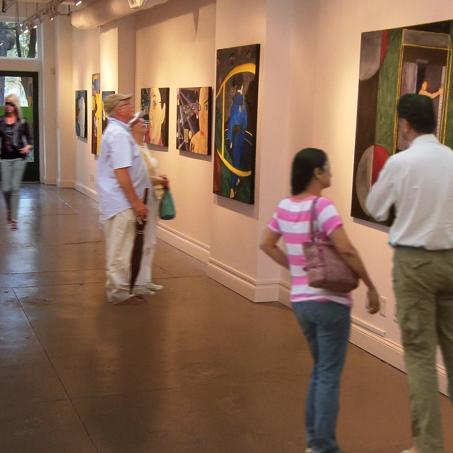• In Human Terms •
•November 2013•
In his much anticipated first solo exhibition, In Human Terms, David Paxton creates a cohesive theme, a single thread pulling viewers from piece to piece. He presents a visually sumptuous, yet cynical, representation of ideal contemporary romantic relationships and the freedom presented by a generation of individualists.
The paintings are all oil on canvas, the brushwork bold in stroke and color, and emphasize the figure field relationship. Viewing the paintings, one can imagine the energy and power utilized in the creation of each piece, yet at the same time a striking juxtaposition is created in the delicate nature of intricate detailing in the gold leafing and individual portraits and figures.
In Human Terms represents a collection of Mr. Paxton’s current pieces, each acting as a snapshot frozen against discordant, yet stunning, backgrounds. The individual works stand independent of one another, nonetheless taken as an interconnected whole the paintings document the turbulence of a relationship between two people. The individuals struggle for dependence, independence, dominance, and encounter a persistent loneliness dominating the work.

Perhaps the most striking of the works is also the show’s most intimate, which set the initial pace and tone of the exhibition. Although divided into four panels, Paxton’s Symphony No. 2, Tango, spans a remarkable 24 feet and is near six feet tall. Awash with deep, swirling red and orange, inspired by the composer Astor Piazolla’s masterpiece “Zero Hour,” the paintings document the four main movements of that iconic music: love, tragedy, comedy, and kilombo (whore-house/mess).
The first panel shows a man and woman dancing. Viewers find the two caught in the final pose of an impassioned tango. Their faces are flushed, stomachs and hips pressed together, limbs and hands possessive, grasping at one another. The painting captures the struggle for dominance. The overt sensuality permeating all of Paxton’s paintings reaches an apex in the charged sexual tension expressed in the controlled forms of the dancers. His arm pulls hers a fraction too far for comfort, her leg strains in the forefront, the muscles taut as she clamps his upper thigh. However, the violence of the dance is softened by the gaze exchanged by the two. They seem to partake of a secret, a shared thought transforming the violence into a playful game of wills.
This selected gathering of paintings addresses the principles of romance and individual independence, questioning the price of such ideals. Within the painted patterns of abandonment, missed communication and self-exploration there persists an obstinate hope. Among Paxton’s work exists a deliberate search for clarity in the deceptive, simple emotions and convoluted motivations of today’s humans. Hiss work is ambitions, imperfect, altogether subjective and, for those fortunate enough to view, totally immersive.
Audrey Reda
Curator
